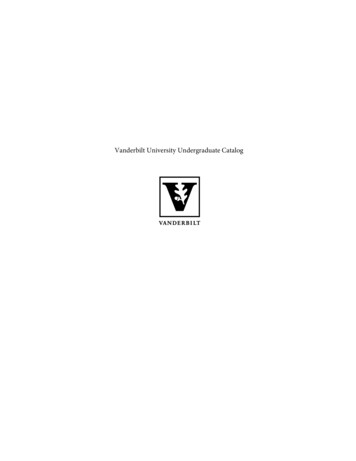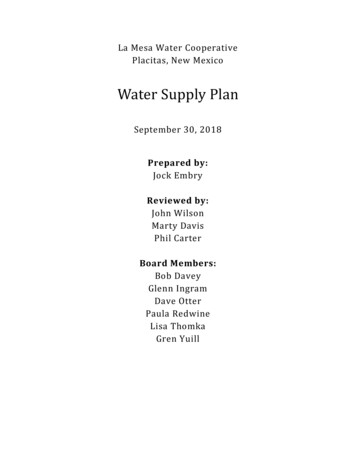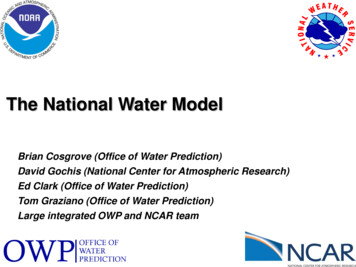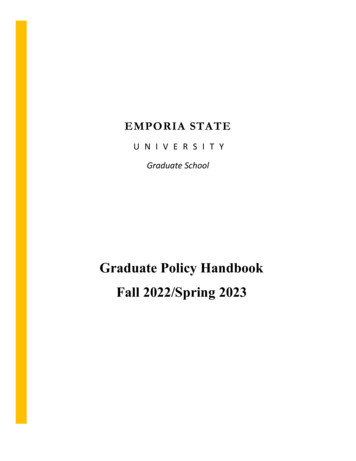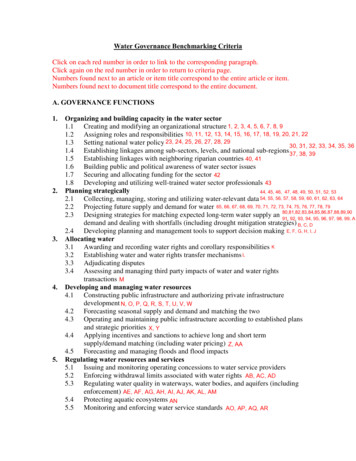
Transcription
Water Governance Benchmarking CriteriaClick on each red number in order to link to the corresponding paragraph.Click again on the red number in order to return to criteria page.Numbers found next to an article or item title correspond to the entire article or item.Numbers found next to document title correspond to the entire document.A. GOVERNANCE FUNCTIONS1.2.3.4.5.Organizing and building capacity in the water sector1.1 Creating and modifying an organizational structure 1, 2, 3, 4, 5, 6, 7, 8, 91.2 Assigning roles and responsibilities 10, 11, 12, 13, 14, 15, 16, 17, 18, 19, 20, 21, 221.3 Setting national water policy 23, 24, 25, 26, 27, 28, 2930, 31, 32, 33, 34, 35, 361.4 Establishing linkages among sub-sectors, levels, and national sub-regions 37, 38, 391.5 Establishing linkages with neighboring riparian countries 40, 411.6 Building public and political awareness of water sector issues1.7 Securing and allocating funding for the sector 421.8 Developing and utilizing well-trained water sector professionals 43Planning strategically44, 45, 46, 47, 48, 49, 50, 51, 52, 532.1 Collecting, managing, storing and utilizing water-relevant data 54, 55, 56, 57, 58, 59, 60, 61, 62, 63, 642.2 Projecting future supply and demand for water 65, 66, 67, 68, 69, 70, 71, 72, 73, 74, 75, 76, 77, 78, 792.3 Designing strategies for matching expected long-term water supply an 80,81,82,83,84,85,86,87,88,89,9091, 92, 93, 94, 95, 96, 97, 98, 99, Ademand and dealing with shortfalls (including drought mitigation strategies) B, C, D2.4 Developing planning and management tools to support decision making E, F, G, H, I, JAllocating water3.1 Awarding and recording water rights and corollary responsibilities K3.2 Establishing water and water rights transfer mechanisms L3.3 Adjudicating disputes3.4 Assessing and managing third party impacts of water and water rightstransactions MDeveloping and managing water resources4.1 Constructing public infrastructure and authorizing private infrastructuredevelopment N, O, P, Q, R, S, T, U, V, W4.2 Forecasting seasonal supply and demand and matching the two4.3 Operating and maintaining public infrastructure according to established plansand strategic priorities X, Y4.4 Applying incentives and sanctions to achieve long and short termsupply/demand matching (including water pricing) Z, AA4.5 Forecasting and managing floods and flood impactsRegulating water resources and services5.1 Issuing and monitoring operating concessions to water service providers5.2 Enforcing withdrawal limits associated with water rights AB, AC, AD5.3 Regulating water quality in waterways, water bodies, and aquifers (includingenforcement) AE, AF, AG, AH, AI, AJ, AK, AL, AM5.4 Protecting aquatic ecosystems AN5.5 Monitoring and enforcing water service standards AO, AP, AQ, AR
B. GOVERNANCE PROCESS CHARACTERISTICS1.Transparency. AS, AT2.Participation. AU, AV3.Accountability and Integrity. AW, AX, AY4.Rule of law.5.Coherency and Integration. AZ6.Responsiveness. BA, BBC. CROSS CUTTING CATEGORIES1.Water Sources1.1 Surface water BC, BD, BE, BF, BG, BH, BI, BJ, BK1.2 Groundwater BL, BM, BN, BO, BP, BQ, BR, BS, BT, BU1.3 Derivative water (reclaimed, reused, desalinated) BV, BW, BX, BY, BZ, CA, CB, CC, CD, CE, CF2.Water Uses2.1 Irrigation CG, CH, CI, CJ, CK, CL2.2 Municipal CM, CN, CO, CP, CQ, CR2.3 Industrial CS, CT, CU, CV, CW2.4 Environmental CX, CY, CZ, DA2.5 Hydropower DB2.6 Fisheries, navigation, recreation2.7 Other uses (including social, esthetic, and religious uses) DC, DD, DE, DF, DG
German Technical Cooperation- GTZMinistry of Water andIrrigationThe Hashemite Kingdom ofJordanThis plan has been authored by the Water Sector Planning Support Project in theframework of cooperation between the Ministry of Water and Irrigation and GTZ, withsupport from AHT, BGR, Engicon, Dr. Fritz Käser and Siegfried Holtkemper.
The National Water Master PlanObjectivesWithout water, there is no life. Individuals, private companies and public institutions aretaking great efforts to make water useable for their needs - be it drinking water, pastoralneeds, industries, agriculture or others. In order to coordinate these activities, and tosafeguard that the resources are also available for future generations, a common planningframework is needed. This framework is given by the Water Master Plan.According the United Nations, the primary objective of a Water Master Plan is toestablish a basic framework for: orderly and integrated planning and implementation of water resources programsand projects; anda rational water resources management consistent with overall national socioeconomic development objectives.(Guidelines for the preparation of National Water Master Plans, Water Resources Series No. 65, UN, N.Y.1989)Background and Principal ComponentsThe Formulation of a Water Master Plan is a principal task of the state. In the HashemiteKingdom of Jordan, this task is performed by the Ministry of Water and Irrigation. Theold Masterplan from 1977, which had been formulated with assistance the GermanGovernment, needs to be updated and revised. Again, the German Agency for TechnicalAssistance (GTZ) is supporting the Jordanian Government in this task.The new Masterplan will not be a static printed document but a Digital Water MasterPlan based on an extensive Water Information System (WIS). In close cooperationwith the Ministry of Water and Irrigation and GTZ, the German consulting companyAHT International has developed the Digital Planning Tools. These software tools are 44, E, BAdatabase applications with a GIS (digital mapping) interface that are applied to: Assess the present availability, withdrawals, losses and uses of the waterresources;Formulate alternative development scenarios for water resources and demand/useat various planning horizons;Perform the balancing of resources versus demands for the recent past as well asfor the alternative development options andIdentify technical and operational options in order to bridge the gap betweenresources and demands. 65, 802
Basic components and functionality of the Digital MasterplanWater Information System (WIS) FThe Digital Water Master Plan receives its data from the Water Information System(WIS). This is the central information system at the Ministry of Water and Irrigation,serving the Ministry as well as WAJ (Water Authority of Jordan) and JVA (Jordan ValleyAuthority). In addition, it is the authorised source for data on water monitoring,management, and planning for external users like research institutions or internationaldonors.The WIS is a complex system of hard- and software, data and tools as well as people forits operation and maintenance. It can be accessed from all computer workplaces withinthe Ministry’s network. The majority of data is either stored in ORACLE data base tablesor in GIS files. These two data systems are linked, thus permitting both the data selectionby inter-active maps and cartographic representation of results.The WIS contains monitoring data collected in the field either by operators of the watersupply and wastewater disposal systems (namely WAJ and JVA), the hydrologicalservice of the Ministry and/or external institutions like the Department of Statistics andthe Ministry of Agriculture. In addition to the monitoring data the WIS holds the resultsof water demand and resources projections.In order to facilitate data exchange, a unified coding compulsory for all water authoritiesis under development. This process is coordinated by the Working Group onStandardization of Data and Information Flows. 303
The two primary user interfaces of the WIS are the Data Entry and VisualisationApplication (DEVA) and the Digital Visualisation System (DVS). The DEVA (writtenunder Oracle developer) is both used for data entry and the production of reports in afixed format.The DVS is specially made for the master plan allowing to produce standard informationproducts in an automated way. It is an MS-Access application with integratedMapObjects GIS modules for spatial selection and cartographic outputs. The DVS isapplied to monitoring and forecast data to produce standardized tables, charts and mapsunder Excel. Thus, its results can be easily post-processed with Office software.4
Examplesof userinterfacesof theDVSsoftware5
Digital Planning ToolsThe Digital Planning Tools are a set of interactive software modules applied to forecastwater resources and demands for future development scenarios. These forecasts arealways using recent monitoring data as a starting point. The results are stored into the socalled Scenario Tables Pool (STP), which is part of the central ORACLE databaseadministered under the WIS. From there, the information on future resources anddemands is taken for nation-wide water balancing. 66, GPrincipal data flow – from the pre-processing modules to balancingThe Digital Planning Tools have been developed under MS-Access 2000 in VBA (Visualbasic for Applications), the most common programming language under the Windowsoperating system. The Digital Planning Tools have a modular structure and the softwarecode is open to the IT personnel in the Ministry. This will allow future modifications andextensions with the Ministry’s own resources.Examples of user-interfaces of the digital planning tools for resource estimation6
Example of a user-interface for demand estimation (irrigation)Digital NWMP7
A Water Master Plan as a document is consisting of the following principal parts: 45 The description of the water resources (surface and ground water plus alternativeresources) in quantity and qualityThe description of the present and likely future development of water demands bydifferent user sectors; 67The presentation of the technical (physical) and operational water managementmeasures to fulfil the demands in their temporal and spatial distribution underconsideration of social, environmental and economic aspects. 81Due to the complexity of the task, a master plan is structured in several layers likeexecutive summary, main report (in several volumes) and various technical annexes andappendices.A digital master plan is such a document in digital or electronic format. This has severalbig advantages: portability (the whole document fits to a CD-ROM) and easy navigationwithin and between the various parts and layers of the document. Most important,however, is the facility to easily update the document.To obtain that functionality, two additional features are required. First, the documentmust have a standardized structure of small individual units linked with each other. It wasagreed to use in principle the system-independent file formats HTML (hyper text markup language, which is commonly used for Internet web pages) and PDF (portabledocument format). Secondly, an additional software shell is required to convert the “rawdocuments” into the agreed document formats in order to integrate them into the overallstructure of the digital master plan.8
9
General document concept of the screen version of the digital master planContributions for the NWMP31I. From the Ministry of Water and IrrigationNWMP DirectorateDirector: Eng. Suzan TahaEnvironment, Wastewater:Groundwater Quality, Data Management:Demand Forecast:Industrial Wastewater, Demand Forecast:Institutional Issues:Eng. Rania Abdel KhaledEng. Lana NaberEng. Rasha SharkawiEng. Nisreen HaddadinEng. Nisreen HaddadinWater Resources DirectorateDirector: Eng. Edward QunqarMonitoring Network:Hydrology:Groundwater Water Monitoring:Geology:Groundwater Modeling:Dr. Issa NsourEng. Zakaria Haj-AliDr. Issa Nsour, Eng. Ali SubahEng. Ali Subah, Eng. Mazen RayanEng. Nidal KhalifehProject Finance DirectorateDirector: Eng. Maysoon ZoubiProject Cost Assessment:Investment Programming:Eng. Hisham BashirEng. Maysoon ZoubiMIS DirectorateDirector: Eng. Mohammad Bany MustafaDatabase Administration and Programming:Eng. Ibtisam Al SalehII. From the Jordan Valley Authority (JVA)Dams Department, GIS-Department, MIS Directorate, Deir Alla Control Center and Laboratories, JVAInvestment Directorate.III. From the Water Authority of Jordan (WAJ)10
Operation and Maintenance Directorate, Sewage Operation Directorate, Billing Department, MISDirectorate, Ground Water Basins Department.IV. From the Planning & Management Unit (PMU)UFW DirectorateIV. OthersRoyal Scientific Society, Ministry of Agriculture, Department of Statistics, Ministry of Planning, Ministryof Tourism, Yachiyo Engineering - Japan, BGR - Germany, EMWIS (Euro-Mediterranean InformationSystem on the Know How in the Water Sector), ARD - USA, Richard AllenEng. Suzan TahaDr. Philipp MagieraProject Co-ordinatorTeam Leader - GTZe-mail:Suzan ry of Water and IrrigationTel. 962(6) 5685 389 – Fax.389P.O.Box 2412 - 5012 Amman / Jordan11 962(6) 5685
22.1Planning FrameworkThe Institutional and Legal FrameworkThe Government of Jordan strives to implement a sound legal and administrativeframework to best address the foreseeable striking future water shortage. 232.1.1 Water Administration and Water Utilities inJordanThree institutions take responsibility for water administration in Jordan: Ministry ofWater and Irrigation (MWI), Water Authority of Jordan (WAJ), Jordan Valley Authority(JVA)MWI is the official body responsible for the overall water and wastewater system and therelated projects,planning and management, the formulation of national water strategiesand policies, research and development, information systems and procuring financialresources.WAJ was established as an autonomous corporate body, with financial and administrativeindependence linked with Minster of Water and Irrigation. WAJ became responsible forthe public water supply and wastewater services as well as for the overall water resourcesplanning and monitoring, construction, operations and maintenance. WAJ's ProjectManagement Unit (PMU) regulates water and wastewater utilities under privatemanagement.JVA has been established for the social and economic development of the Jordan RiftValley including the development, utilisation, protection and conservation of waterresources. The King Abdallah Canal represents the backbone of the JVA waterdistribution system in the north of the Dead SeaWAJ and JVA are by law responsible for water supply and wastewater services in Jordan.The Government of Jordan considers private sector participation and decentralisation asmajor elements of the reform process fostering the efficiency in the public service sector. 24, AUSince 1999 the water supply in Greater Amman is under private management. Majorfuture water and wastewater projects are foreseen for further private sector participation.2.1.2 Legal Framework for National WaterResources ManagementWithin the context of the National Water Master Plan the national management level is ofparticular relevance and plays an important role with respect to information availability,12
co-ordination, policy development, planning, the legal framework, and human resourcesdevelopment as required for integrated water resources development and management(compare ICWE, 1992).2.1.2.1Principal Legislative Provisions10Legal responsibilities with regard to water resources monitoring and planning exist forMWI, WAJ and JVA. The Jordanian Institute of Standards and Metrology is chargedwith the duty of issuing standard specifications for the water sector in cooperation withrepresentatives of MWI, WAJ, JVA and representatives of the Ministry of Health and theMinistry of Environment. 32With due consideration of the provisions of the Water Authority Law, the Jordan ValleyDevelopment Law and any other amending or substituting laws thereof, MWI assumesfull responsibility for water and public sewage in the Kingdom as well as for the projectspertaining thereto. MWI prepares the National Water Master Plan and water sectorprograms, formulates water sector policies and participates in the licensing of waterabstractions.2.1.2.2Water Resources Management Information 46Legal responsibilities for collecting water resources data and water sector planning existfor MWI, WAJ and JVA. The Ministry of Water established a comprehensive nationalwater data bank as part of the Water Information System to support planning anddecision-making processes. The major internal data source is the water resourcesmonitoring network operated by the Water Resources Directorate of the Ministry. Waterand wastewater production data as well as wastewater quality data are being collectedfrom WAJ and JVA and entered to the WIS in MWI. Surface water quality is monitoredby different entities and is not systematically covered by a nation wide monitoringnetwork. Surface water quality is monitored by JVA along the Zarqa River course by theRoyal Scientific Society in commission of WAJ.Water sector project management is presently a task of WMI, WAJ and JVA, while MWIis responsible to pursue planning and monitoring of donor-funded projects. A centralproject database and a coordinating body for data and information management does notyet exist in the water sector.2.1.2.3Human Resources Development 43According to the existing legislation MWI, WAJ and JVA manage personnel as internalaffairs in line with provisions of the Civil Service OrdinanceNo. 55 of 2002. The saidregulation is posing difficulties on the water authorities in recruiting and sustainingqualified staff with key capabilities in integrated water resources management such asfinance management, computer aided water sector planning and informationmanagement/information technology.13
2.2The Policy Framework and Water SectorStrategiesNotwithstanding a very difficult regional and international environment, coupled withcritical political and economic challenges, the Government of Jordan is undertaking anambitious economical restructuring process, moving the economy from being publicsector oriented into one where the private sector plays an important role. 1In accordance with Article 5 of the Water Authority Law No.18 of 1988 and pursuant tothe Council of Ministers approval, the basic strategy and policies for the water sector ofJordan have been formulated and published by the Ministry of Water and Irrigation.A sustainable use of the scarce natural water resources, in line with a continuousimprovement in living conditions for the country's population, is the outstandingdevelopment goal for the water sector of Jordan. 252.2.1Water Resources StrategiesOn a per capita basis, Jordan is one of the water scarcest countries in the world. Thereforepriority is given to the sustainability of use of the natural resources. On the other hand thefull potential of surface water and groundwater shall be tapped to the extend permissibleby feasibility, and by social and environmental impacts. BC, BL, CX, DCJordan receives a large share of its water resources from international watercourses,namely Yarmouk River, Jordan River and the trans-boundary aquifers. The rightfulshares shall be defended and protected through bilateral and multilateral contracts,negotiations, and agreements. The optimal regional water option and the relatednecessary degree of cooperation shall be determined by weighing various options undereconomical, political and environmental considerations. 40Wastewater shall not be treated as waste. It shall be collected and treated in accordancewith WHO and FAO Guidelines that allow its reuse in unrestricted agriculture and othernon-domestic purposes, including groundwater recharge. The existing level of servicesshall be sustained and promoted. BV2.2.2Allocation and Development StrategiesThe priority criterion for project implementation, and for additional water allocation shallbe based on economic, social and environmental considerations. First priority will begiven to the basic human needs; as such first priority is given to allocation of a modestshare of 100 litres per capita per day to domestic water supplies. Expensive additionalwater has municipal purposes as a first priority in allocation, followed by tourism andindustrial purposes. 26, K, BB, CM, CS, DD14
Existing areas of irrigated agriculture shall be accorded to the chances for sustainability.Sustainability of agriculture shall be compromised only if it threatens the sustainability ofgroundwater resources. For irrigation purposes, and in the light of the tight watersituation, wastewater is considered a resource and cannot be treated as waste. BW, CG2.2.3Water Quality and Pollution Control StrategySetting and enforcing national health standards shall be enhanced and sustained,especially in regards of municipal water supply. CNCollection and treatment of wastewater is considered obligatory in order to protect publichealth against water borne diseases. Wastewater shall be collected and treated inaccordance with WHO and FAO Guidelines that allow its reuse in unrestrictedagriculture and other non-domestic purposes. AERecharge areas of aquifers shall be protected to the maximum extend possible. Conflictsarising out of urbanization shall be addressed, and mitigation measures specified for theurban planners to have them included in the urban planning process. Over-abstractionfrom the aquifers shall be reduced to sustainable levels. 82, M, ABA network of observation wells shall be installed in each of the groundwater reservoirs orpart thereof for the purpose of monitoring and laboratories for pollution controls shall bemaintained and properly equipped. 472.3The Regional FrameworkFor the regional review of the present utilization and the potential allocation of the waterresources, spatial units need to be defined. In addition to natural catchments, which are ofpriority for allocation plans due to ecological constraints, socio-economic regions andadministrative units are of importance in order to consider overall development goals inthe water allocation strategy. 48In order to assure that the proposed water allocation meets the socio-economicdevelopment needs of the country, socio-economic development areas have beendelineated. The definition of the socio-economic areas is based on the following criteria:population and population density, irrigation areas, irrigation density and industrial waterconsumption. 832.4Water Sector DevelopmentDespite enormous progress in water supply and sanitation, Jordan needs to challengeincreases in demand running ahead of water resources developments due to vastpopulation growth and rising per capita demands. These challenges require gainingefficiencies throughout the water sector, namely in institutional development, in waterresources development and demand management as well as in water allocation with due15
respect of private sector participation. Hence Jordan's water sector development shallfollow the principals of an integrated water resources management securing the needs offuture generations. 84The economical restructuring process, aiming to move the Jordanian economy from itspublic sector orientation into one where the private sector plays an important role, hasstrong implications on the institutional development in the water sector. Therefore, thepresent legal/institutional set-up for the water sector needs adjustments to match therequirements of the future more commercially oriented service sector: 2A lean and efficient administration which is going to oversee water sectordevelopment in the light of national socio-economic needs, and environmentaland sustainability implications.A sound legislation allowing private sector participation, whose operations will bescrutinized for their service orientation and efficiencies, and compliance with theset national development objectives. 3 The Ministry of Water and Irrigation has elaborated an action plan (MWI, 2002c) inorder to address the above-mentioned development goals. This action plan has beenapproved by the Cabinet of Ministers and shall be updated in due time.2.4.1Legislative DevelopmentThe Ministry of Water and Irrigation needs to be legally empowered to take the lead in allmatters related to national water resources and project management on the national scaleto assure a sound water sector development. This scope of responsibility shouldcomprise: 11 Water sector legislation and water standardsNational water master planning and policies,National water resources and project management,Water rights.The present water legislation is rather meant to define institutional responsibilities than todefine an overall comprehensive vision for the national water resources management.Hence, at present overlapping responsibilities arise in between the different relevantwater sector institutions. Therefore it is recommended to issue a comprehensive WaterLaw, which streamlines the existing water sector legislation. 4, AZThe National Water Master Plan should be legally empowered as superior plan for allwater sector development plans to assure consistent orderly planning on alladministrative levels in line with the overall national water strategy (UN, 1989).Investment planning should be considered an integral part of the National Water MasterPlan. 2716
Water rights and project financing are the major means to implement water sectorstrategies. Hence, the responsibility in this respect should be with MWI. 122.4.2Institutional DevelopmentMWI, WAJ and JVA shall remain the administrative institutions with an overallresponsibility for the water sector in Jordan. The organisational set-up of the institutionsis recommended to be restructured for the sake of efficiency improvement and coherencewith the proposed responsibilities of the Ministry of Water and Irrigation. The tasks ofeach institution shall be clearly defined and reflected in an officially introduced businessdistribution plan with an organisational chart and job descriptions for all staff. 5, 13All possible forms of private sector participation shall be in principal applicable for theimprovement of service efficiency and viability in the water sector.Decentralisation shall be applied wherever appropriate in order to increase transparencyand customer orientation in all services and to ensure an appropriate participation of localcommunities in all phases of water management (compare ICWE, 1992). AS, AVThe operation of water supply and wastewater utilities should be strictly separated fromany resources monitoring in order to avoid interest conflicts. AW2.4.3Water Resources Development and AllocationJordan's renewable natural water resources including Yarmouk River water are estimatedto be in the range of 800-850MCM/a out of which 275 MCM/a are considered sustainablegroundwater abstractions from wells and springs (safe yield). The contribution of theYarmouk River is considered to be 230 MCM/a. BDThe actual groundwater abstraction exceeds the said safe yield by far and reachespresently approximately 180 % of the safe yield. About 50 % of the groundwater is usedfor irrigation purposes. As the present groundwater abstractions are not sustainable, theGovernment of Jordan envisages to reduce the groundwater abstractions continuously toreach the safe yield level by the year 2020. It is foreseen to substitute groundwater withreclaimed water in agriculture and industrial use. Increasing wastewater collection andappropriate wastewater treatment and reuse are therefore of high priority. Water reuse isexpected to exceed 200 MCM/a by the year 2020, while the present reuse is in the range70 MCM/a. It is worthwhile mentioning, that farmers in the southern Jordan Valleyoperate private desalination plants to treat brackish groundwater for irrigation waterproduction. 49, 68, 85, BM, BXA major additional groundwater resource is foreseen to be developed in Disi. From thisnon-renewable resource about 100 - 125 MCM are planned to be tapped for M&Isupplies. BN17
The development of surface water resources requires sufficient reservoir capacities. Theplanned dam capacity will deliver estimated safe yield of 191 MCM in 2005. Furtherdams are under construction in order to provide additional reservoir capacities in therange of 60 MCM with an expected safe yield of 272 MCM until 2020. N, BEDesalination of seawater and brackish water is foreseen to contribute up to 55 - 60 MCMto M&I supplies. BYIn total it is planned to increase net supply to municipal and industrial uses frompresently 280 - 290 MCM/year to about 380 MCM/Year in the year 2020. BZDuring the above-mentioned planning period adequate action shall be taken to reducegroundwater abstractions to the safe yield level to protect Highland aquifers fromsalinisation. CA2.4.4Demand Management ZDespite ongoing projects and plans to mobilise additional water resources, options forfurther resources development are very limited and demand side oriented management isof increasing importance similar to other countries in the region.2.4.4.1Demand Management"Water Demand Management" is an objective oriented approach to influence "WaterDemand" by means of macro- and micro-economic measures (market policies,marketing, pricing), quoting and/or rationing, education and public awareness risingWater demand management within the framework of integrated water resourcesmanagement encompasses various functions to increase allocation and water useefficiency. Various projects have been set up to reduce water consumption and to reducewater losses.2.4.5Scenario Development and Balancing AnalysesDynamic population growth, wide spread poverty and very limited natural waterresources characterise the conditions for Jordan's future economic development.Notwithstanding these adverse development conditions considerable progress inimproving people's living conditions could be achieved through decisive economicalreforms and fostering free trade, tourism and information technology.Within the framework of the NWMP demand development and resources availabilityhave been projected until the year 2020. 6918
2.4.5.1Water Demands70Po
a rational water resources management consistent with overall national socio-economic development objectives. (Guidelines for the preparation of National Water Master Plans, Water Resources Series No. 65, UN, N.Y. 1989) Background and Principal Components . The Formulation of a Water Master Plan is a principal task of the state. In the Hashemite




